Concert Report: Tutti Contenti at Amadeus Live
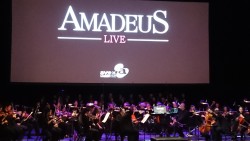

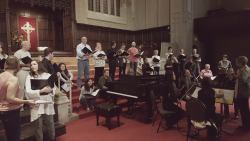 Toronto is a definitive choral city. With choral music of diverse shapes and sizes across the region, there is a strong appreciation for voices joined together. Every so often a great gem of a performance comes along and proves this – and the Luminous Night Festival Gala Concert was one of those.
Toronto is a definitive choral city. With choral music of diverse shapes and sizes across the region, there is a strong appreciation for voices joined together. Every so often a great gem of a performance comes along and proves this – and the Luminous Night Festival Gala Concert was one of those.
Yorkminster Park Baptist Church is one of the busiest churches for music in the city. Several choirs call it home and two, the Orpheus and Church choir, joined together for the third edition of their Choral Encounters initiative (this year titled the Luminous Night Festival). Born out of the work of several conductors in the GTA region, the idea is to bring together academy, community, and church around a living composer. In 2013, the inaugural year, that composer was Alice Parker. In 2014 it was Morten Lauridsen. This year we had the great pleasure of experiencing Ola Gjeilo.
A Norwegian composer trained at Juilliard, Gjeilo has proven himself a world-loved composer. His accessible writing features beautiful, lush, thick sounds. His work is often set to Latin but includes English and poetry by Charles Anthony Silvestri. His compositions are evocative of ebbing and flowing, of movement like waves and water. The melodies are grand, warm and embracing, but as he says in his own words, “still intimate”.
Rarely will one ever find such an exquisite collection of choral gems – both repertoire and ensembles – in one place. The Luminous Night gala concert featured the University of Toronto Faculty of Music’s Women’s Chamber Choir, Macmillan Singers and Exultate Chamber Singers under Hilary Apfelstadt; Resonance, the youth choir of the Mississauga Festival Choir, conducted by Bob Anderson; the Yorkminster Park Baptist Church Choir, conducted by William Maddox; and the Orpheus Choir, conducted by Bob Cooper.
Each ensemble showed skill and musicality that was pleasing not only because it was the work of Ola Gjeilo, but also because the diversity of voices provided a unique experience for listeners. The mature voices of the Yorkminster Park Baptist Church Choir were quite a contrast to the clear, bright, present sound of Exultate Chamber Singers. Each ensemble was pleasingly different in its own way.
Specific credit goes to Resonance, particularly their sopranos. Their interpretation of Serenity – my favourite of Gjeilo’s pieces – was exquisite. Their balanced sound and understanding of the music flowed through the church. It was truly a dream to listen to these young voices make such beautiful music.
The University of Toronto ensembles were also at the top of their game, both balanced and present. Their artistry showed depth and an exquisite balance of sound, with the lower voices supporting very controlled soprano notes. Eunseong Cho was particularly spectacular on the piano for Tundra, providing a powerful interpretation to suit the dynamic Women’s Chamber Choir.
Gjeilo’s Sunrise Mass continues to be a popular and accessible choice for choirs. In this festival the massed power of the Orpheus Choir, Resonance, and the Yorkminster Park Baptist Church Choir joined with the Talisker Players under Bob Cooper. The Taliskers were musical accompaniment sent from heaven, with clear articulations and rhythmic energy that the choir was mostly consistent with. The double basses were especially useful in tuning the choir through some tricky intervals and dissonances. The ensemble’s musicality – and its understanding of the flow of the music, with its undulating string accompaniment – energized the singers’ beautiful, melodious lines.
I have sung in massed choirs a few times and the one plague of having so many singers in one place is a default legato. When there is so much sound and so many people the precision can suffer. This was slightly noticeable through the The City movement of the Sunrise Mass. Still, there is something incredibly humbling about being in the presence of about 200 singers. The only other comparable experience is a congregation singing hymns during liturgy. Both experiences can be overwhelmingly beautiful.
One other great opportunity with a concert like this is to see different conductors in action. Bob Cooper’s energy comes from his elbows and shoulders, his expression generating from his upper carriage into the music. William Maddox presented his hands upwards, conducting as if in welcoming prayer. Bob Anderson conducted Resonance with palms down, stroking the sounds and energy out of his choir with detailed communication through quick movements and subdivided cues. And Hilary Apfelstadt – the only conductor to use a baton – executed her work with precision, strength and clarity. Hilary’s clarity in conducting transferred right across the three different ensembles she conducted over the evening.
One can only wish that Choral Encounters grows with each year, and that we continue to have amazing choral experiences because of their hard work.
The Luminous Night Festival Gala Concert was on Saturday, October 15 at 7:30pm, at Yorkminster Park Baptist Church.
Follow Brian on Twitter @bfchang. Send info/media/tips to choralscene@thewholenote.com.
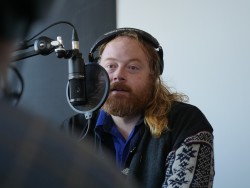
To hear the full conversation with Edwin Huizinga click the play button below. For any of our other podcasts, search for “The WholeNote” in your favourite podcast app, or go to TheWholeNote.com/podcasts for the entire list.
Or click here to download the podcast. (Right click and "Save as..." if it's playing directly in your browser.)
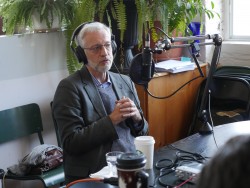
Or click here to download the podcast. (Right click and "Save as..." if it's playing directly in your browser.)
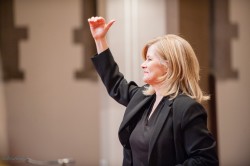 Choral conductors discuss duelling Nov 5 Elijahs
Choral conductors discuss duelling Nov 5 Elijahs
To hear the full conversation with Stephanie Martin and Noel Edison click the play button below. For any of our other podcasts, search for “The WholeNote” in your favourite podcast app, or go to TheWholeNote.com/podcasts for the entire list.
Or click here to download the podcast. (Right click and "Save as..." if it's playing directly in your browser.)
![]() A Toronto staple since 1991, the Summerworks festival bills itself as “the breeding ground for the mainstage shows of the future.” As always, this year’s festival has committed to putting music theatre in its programming, and this year, its musical component has certainly kept with this forward-thinking mandate. The festival’s musical offerings this year, many of them focused on the communicative power of the human singing voice, have made bold statements–not only for musical reasons, but because the tropes and trends on which they rely are well-poised to strike an uneasily familiar chord with audiences.
A Toronto staple since 1991, the Summerworks festival bills itself as “the breeding ground for the mainstage shows of the future.” As always, this year’s festival has committed to putting music theatre in its programming, and this year, its musical component has certainly kept with this forward-thinking mandate. The festival’s musical offerings this year, many of them focused on the communicative power of the human singing voice, have made bold statements–not only for musical reasons, but because the tropes and trends on which they rely are well-poised to strike an uneasily familiar chord with audiences.
 Mr. Shi and His Lover, running August 5 to 13 at The Theatre Centre, is one such piece of music theatre. Based on the real-life story of the love affair between French diplomat Bernard Boursicot and male Chinese opera singer Shi Pei Pu, Mr. Shi blends musical elements from opera (both Chinese and European), pop music and Chinese folk song into a 90-minute interrogation of the couple’s relationship. Presented by an international team of artists from both Toronto and Macau Experimental Theatre, and performed in Mandarin with English surtitles, Mr. Shi is new territory for Summerworks, with largely successful results.
Mr. Shi and His Lover, running August 5 to 13 at The Theatre Centre, is one such piece of music theatre. Based on the real-life story of the love affair between French diplomat Bernard Boursicot and male Chinese opera singer Shi Pei Pu, Mr. Shi blends musical elements from opera (both Chinese and European), pop music and Chinese folk song into a 90-minute interrogation of the couple’s relationship. Presented by an international team of artists from both Toronto and Macau Experimental Theatre, and performed in Mandarin with English surtitles, Mr. Shi is new territory for Summerworks, with largely successful results.
There is a subtlety to Mr. Shi that is not always audible at first listen. The music and plot rely heavily on clichés: characters sing platitudes about life and love, fall weeping to their knees, and comment on the nature of East and West through the lens of Madama Butterfly. It is baffling, until one realizes that all of these tropes are intentionally self-referential–and undeniably operatic. In this light, Mr. Shi transforms itself into a type of post-opera, one that exploits the orientalist spectacle so prevalent in opera while at the same time revealing its racist, gendered nature.
These layered messages are delivered movingly by Jordan Cheng as the conflicted and contemplative Mr. Shi, as well as by Derek Kwan, who plays the equally troubled Bernard. Carol Wang (percussion) and Njo Kong Kie (composer/piano) provide instrumental support as the minimalist onstage accompaniment.
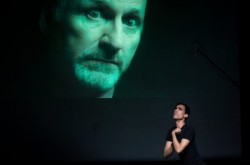 In Imaginary Anthropologies, running August 5 to 13 at Factory Theatre, Gabriel Dharmoo serves as solo vocalist and theatrical mastermind behind a series of invented vocal traditions from ‘cultures’ around the world. Presented mockumentary-style, with Dharmoo pitted against an onscreen panel of anthropology ‘experts,’ Imaginary Anthropologies is highly weird and sharply witty. Dharmoo asks that audiences not give too much away about the show–but suffice it to say that the type of ‘anthropology’ conducted throughout the performance, and the way it resonates in our postcolonial, racially hierarchical world, feels uncomfortably familiar. For the audience, who is in on the joke, it is also intensely funny.
In Imaginary Anthropologies, running August 5 to 13 at Factory Theatre, Gabriel Dharmoo serves as solo vocalist and theatrical mastermind behind a series of invented vocal traditions from ‘cultures’ around the world. Presented mockumentary-style, with Dharmoo pitted against an onscreen panel of anthropology ‘experts,’ Imaginary Anthropologies is highly weird and sharply witty. Dharmoo asks that audiences not give too much away about the show–but suffice it to say that the type of ‘anthropology’ conducted throughout the performance, and the way it resonates in our postcolonial, racially hierarchical world, feels uncomfortably familiar. For the audience, who is in on the joke, it is also intensely funny.
Admittedly, both of these shows are difficult to classify, and difficult to place on the musical spectrum. Perhaps that means, though, that they are instead representative of a powerful new type of vocal theatre–one that uses the voice and the stage in ways that make audiences think. Summerworks and the teams of both shows do a great job here, of hitting important issues while all the while committing to the presentation of exceptional theatre–theatre that revels in its own contradictions, and that reveals itself as the bold vanguard of what can be made possible onstage.
Mr. Shi and His Lover plays at The Theatre Centre at 1:15pm on Saturday, August 13, while Gabriel Dharmoo’s Imaginary Anthropologies is onstage at Factory Theatre on Saturday, August 13 at 2:30pm. For details on both shows, visit www.summerworks.ca.
Sara Constant is social media editor at The WholeNote and studies musicology at the University of Amsterdam. She can be contacted at editorial@thewholenote.com.
Meryl Streep walks the finest of fine lines between send-up and sincerity in her inspired portrait of the socialite and patron of the arts, Florence Foster Jenkins (Toscanini was a beneficiary and friend), in this nuanced and enjoyable biopic directed by Stephen Frears: a bon mot here, a visual joke there. For 25 years, the matronly Jenkins promoted classical music through her Verdi Club with annual presentations of vivid tableaux set to the likes of Wagner’s Ride of the Valkyries, in which she would invariably appear, for example, as “the angel of inspiration sent from on high to inspire.”
“We’d rather go without bread than Mozart,” she said.
Finally able to realize her childhood dream of singing after her father’s death, she began performing before her society friends and “music lovers,” ultimately making a record and playing a legendary Carnegie Hall concert in 1944 at age 76. It’s quickly apparent that the voice she heard in her head was not the one that came out of her mouth; it was excruciating and inimitable. The notoriety of her high coloratura soprano is marvellously captured by Streep and Frears in the film which unfolds over the months leading up to the infamous recital.
The Queen of the Night’s aria from Mozart’s The Magic Flute from that evening was gleefully depicted in the film, brazenly off key. Yet by this point, Frears and screenwriter Nicholas Martin had humanized Jenkins, her husband St. Clair Bayfield (wittily underplayed by Hugh Grant) and piano accompanist Cosmé McMoon (Simon Helberg, an adept comic actor whose musical training enabled him to actually play as Streep sang, upping the verisimilitude quotient immensely).
Considering the amount of music that was inherently part of the narrative – Adele’s Laughing Song from Die Fledermaus and The Bell Song from Lakmé (both enthusiastically and lovingly massacred by Streep and Helberg); Respighi’s Valse Caressante (surprisingly sung sweetly and straight by Streep and Helberg); Brahms’ Lullaby serenely done by Anne Sofie von Otter and Bengt Forsberg; Take It Easy by Fats Waller wisely used as an instrumental bridge – Alexandre Desplat’s discreet score was the model of support, lightly orchestrated contemporaneous jazz-based, even riffing on Tchaikovsky’s Pathetique Symphony at a crucial plot point.
Florence Foster Jenkins is currently playing at Cineplex Varsity & VIP and 14 other cinemas in the GTA.
![]() Earlier this year, we came to a twofold realization about summer in Toronto: first, that it’s long, and in a lot of cases, the time when music presenters close up shop for the year; and second, that if local musicians aren’t at their usual musical day-jobs, they must be doing something else. Maybe that seems like an obvious conclusion to come to—but, as we found out, what that ‘something else’ is differs significantly across the local scene. Some performers are touring the festival circuit; others opt to pursue more personal projects that they otherwise wouldn’t have time for; still others take the time as a much-deserved chance to relax.
Earlier this year, we came to a twofold realization about summer in Toronto: first, that it’s long, and in a lot of cases, the time when music presenters close up shop for the year; and second, that if local musicians aren’t at their usual musical day-jobs, they must be doing something else. Maybe that seems like an obvious conclusion to come to—but, as we found out, what that ‘something else’ is differs significantly across the local scene. Some performers are touring the festival circuit; others opt to pursue more personal projects that they otherwise wouldn’t have time for; still others take the time as a much-deserved chance to relax.
This June, we started a series called “How I’ll Spend My Summer Vocation,” to ask around about Toronto’s long musical summer. Where do our opera singers go when the opera house is closed? How do musicians put on concerts when local venues have put a pause on their programming And what do our city’s orchestral players do when most of the major orchestras’ next concerts are in September?
Here are some of their replies.
Instrument: Soprano
How you might know her: Regular appearances with the Metropolitan Opera and COC
Summer Vocation: “The ONE thing that I will be doing this summer vacation, if you can call it a vacation, is resting my voice and NOT singing everyday. I think it is important when a singer sings the difficult repertoire like I sing to actually give the voice a rest and let the muscles in the throat just relax. Also, giving the mind and body a good rest is so important. Plus, then when I come back to singing before the opera season starts, I feel even more excited about getting back to singing and love my music even more. I guess that I just look forward to being a “normal” person in the summer…not having to worry about the voice, what I eat or drink giving me reflux, exercising and keeping up the “regime” plus also just spending time with our friends and family…oh, and driving our cars, if it isn’t raining all summer!”
Hear her next season: Radvanovsky will present a workshop for emerging singers, hosted by the International Resource Centre for Performing Artists (IRCPA), in Toronto on October 12. Radvanovsky will also sing the title role in Bellini’s Norma—sharing the part with Elza van den Heever—this October 6 to November 5 with the COC.
Instrument: Jazz vocalist
How you might know her: “Canada’s Sweetheart of Swing”; regular performer at the Reservoir Lounge
Summer Vocation:
“This summer I’ll be heading to the country and trying to find the groove with my new friend, Lola the horse. I’m delighted to have found an equine who is almost as vocal as me. (She whinnies on average more than the average!) Apart from that, travel usually serves to inspire me: to free up my find from the humdrum of normal life, shake things up, create new ways of thinking and hopefully new project inspiration.”
Hear her next season: In addition to her monthly show at the Reservoir Lounge, Pangman and her band will make appearances at the CNE (September 2 to 3) and at the first-ever Kensington Market Jazz Festival (September 17) this fall.
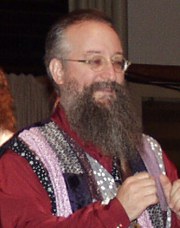 Name: Alan Gasser
Name: Alan Gasser
Instrument: Singer and choral conductor
How you might know him: Co-director of Echo Women’s Choir; co-founder and member of Georgian folk group Trio Kavkasia
Summer Vocation:
“Our family has big plans this summer, a Song Masters study tour in the Caucasus Mountains. I’ve been singing the folk polyphony of Georgia for about 30 years, and travelled to Georgia a handful of times, mostly in the 90s, when my Trio Kavkasia was more active, and when the bigger choir, Darbazi, took shape in my living room. Over the past decade and more, my life in Toronto had family thrills and other musical work, but no possibility for Georgia travel.
I’ve got friends I will be eager to see again, my family members who will thrill to the sights, songs, dances and tastes, and memories to resurrect. The plan includes some time in Lechkhumi, a remote part of the country that many visitors don’t see. Even a day or two in the capital city, Tbilisi. The elevation in Mestia, where we’ll stay for a week, is 1,500 m, but I expect we may get higher than that, emotionally and spiritually.”
Hear him next season: Echo Women’s Choir, led by Alan Gasser and Becca Whitla, plans to perform two main concerts in Toronto this year, in December and May (programs TBA).
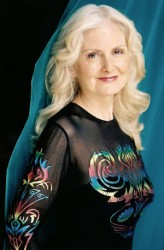 Name: Christina Petrowska Quilico
Name: Christina Petrowska Quilico
Instrument: Piano
How you might know her: Regular solo appearances throughout Toronto and recordings on the Centrediscs label; professor of piano and musicology at York University
Summer Vocation:
“One thing that recharges my battery is learning and recording 7 Mozart Piano concerti at the Glenn Gould Studio in August. Mozart writes such pure and beautiful music that it lifts my heart and soul. I can’t wait to practise the concerti every day.”
Hear her next season: York University boasts a busy concert schedule throughout the school year—including a faculty concert series where Quilico makes regular appearances.
Instrument: Violin
How you might know him: Concertmaster at the TSO and associate professor of violin at the University of Toronto; artistic director designate at the Toronto Summer Music Festival
Summer Vocation:
“I rarely get much of a break in the summers, as festival season starts up right after TSO shuts down for the summer, but this summer is a chance for me to catch up on chamber music, as I’m doing chamber music festivals in Orford, Beijing, Toronto, upstate NY and Maine! The closest thing to orchestra during that time will be performing a Brahms Sextet with Alan Gilbert on 2nd viola- hopefully it will go well and he won’t need to step up to a podium… I’m also doing two weeks at TSM this year- not as AD, but I’ll certainly be hanging around pretty regularly trying to figure out how things work!”
Hear him next season: Crow continues his work with the TSO for a busy 2016/17 season, and will perform throughout North America with the New Orford String Quartet (of which he is a founding member). The quartet will play its first Toronto show of the season on November 1, at U of T’s Walter Hall.
We want to hear your summer stories! If you are a local musician and have a story to share about how you have been spending your own “summer vocation,” send us an email at editorial@thewholenote.com. Here’s to the summer, and to the musical season ahead!
Sara Constant is social media editor at The WholeNote and studies musicology at the University of Amsterdam. She can be contacted at editorial@thewholenote.com.
The Coronation of King George II took place in October of 1727; George Frederic Handel was commissioned to write four anthems for the ceremony. Last July 26, Daniel Taylor led his Theatre of Early Music in a delightful hour-long re-imagining of the event that literally and figuratively was the grand centrepiece of Toronto Summer Music’s “London Calling” season. In addition to using music of the day, Taylor had the wisdom to include three anachronistic elements, Hubert Parry’s I Was Glad and Jerusalem as well as John Tavener’s Hymn to the Mother of God, which broadened the evening and extended the ceremonial maelstrom into the 20th century.
The presence of a real archbishop, a bewigged monarch-to-be and the participation of the large Walter Hall audience in the singing of Jerusalem added to the sense of occasion. The effervescent Taylor and his company had the musical smarts to carry it off. The regal Handel procession and spirited anthems, the big-voiced Orlando Gibbons and the a cappella Palestrina backed up the serious religiosity on display. And Parry’s 1916 setting of Jerusalem, William Blake’s vision of a holy city built “in England’s green and pleasant Land,” crowned the spirit of the British Empire that had ruled the waves for hundreds of years.
TSO concertmaster and TSM artistic director designate, Jonathan Crow, headlined an enjoyable evening of mostly British chamber music, July 28 in Walter Hall. The program began with an invitation into the world of the young Mozart, his Violin Sonata No.10 in B-flat Major, K15, written in London in 1764 while the eight-year-old genius was on a European tour with his violinist sister. Crow and his accommodating collaborative pianist, Angela Park, made the most of the repeated simple theme of the first movement while their well-balanced playing sparked the second.
With Elgar’s meaty Violin Sonata in E Minor, Op.82, the duo’s musicianship was even more evident in the muscular, but sweet, long lines of its first movement. The hugely melodic, virtuosic Romance was filled with tonal contrasts, sensitively played, its lovely pastoral tune and haunting ending, memorable. The finale evoked the English countryside with an Edwardian glow powerfully devolving into fragments of tunes, which it rebuilt into a positive conclusion.
Following intermission, the two were joined by violist Eric Nowlin and cellist Roberta Janzen for a fine performance of Arnold Bax’s Piano Quartet in One Movement. Crow’s musicianship shone and his leadership showed as well, while Nowlin’s rich viola playing made the most of Bax’s notes. Again, Park blended in nicely. With the addition of violinist Bénédicte Lauzière, the group concluded the night with a distinctive tour of Frank Bridge’s Piano Quintet in D Minor. Its massive first movement had a drawing room quality, its rich harmonies sensitively played. The lovely Adagio featured good dialogue among the string players, which enhanced its pristine sadness. The leisurely finale was brightened by the unexpected tunes appearing around the music’s many corners.
A week of exceptional musicality concluded July 29, with an outstanding recital by the talented Dover Quartet (formed in 2008 when its members were 19-year-old students at the Curtis Institute). It was TSM’s nod to the Beethoven Quartet Society of 1845, the first public cycle of the composer’s complete string quartets, a series of London concerts each of which included an early, middle and late quartet. So, in that spirit, the capacity Walter Hall audience was treated to Op.18 No.4, Op.59 No.3 and Op.132.
The Dovers’ playing of the early quartet was empathetic, subtle, impeccably phrased, marked by forward motion, drive and energy. They played up the inherent contrasts in the middle quartet’s first movement, the innocence and aspiration, warmth and solidity of the third and the controlled freneticism of the finale.
But the heart of the evening was the middle movement of Op.132, a work of naked supplication and beauty transformed into optimistic assertiveness. The feeling of divine well-being has rarely been better expressed. (Beethoven was suffering severe intestinal pain as he was about to write the quartet but recovered and wrote in the score, “A convalescent’s hymn of thanks to the Deity in the Lydian mode,” and for the movement’s livelier second theme,“Feeling new strength.”) Musically mature, vibrant and uncannily unified in purpose and execution, the youthful players brought passion and grace to the first two movements, took a decisive approach to the fourth and emphasized the rhapsodic character of the finale.
In a refreshing concert last Tuesday, July 19, Toronto Summer Music presented pianist Pedja Muzijevic’s "Haydn Dialogues,” a 75-minute performance of four Haydn sonatas separated by pieces by Oliver Knussen, John Cage and Jonathan Berger. Passionate about mixing old and new music, Muzijevic is also a genial talker, combining a delicious wit and the occasional catty comment with a streamlined historical sensibility that made it easy to relate to Haydn and his relationship to his patrons, the Esterházy family, and to the timely invitation by the British impresario, Salomon, to live and work in London. (“Talk about London Calling,” Muzijevic added in a clever aside.”)
Muzijevic also likes short concerts. “Don’t you just love an eight-minute sonata,” he said after playing the final London sonata, the two-movement Sonata in D Major, Hob.XVI:51 (1794), redolent with classical architecture.
Continuing TSM’s London Calling theme, Muzijevic chose British contemporary composer Knussen’s Sonya’s Lullaby, Op.16 (1977-8) as his first modern work. Written as a lullaby to get his infant daughter to sleep (“wishful thinking”), it features a scampering atonality amidst a calm underpinning. More a description of a child finally falling asleep rather than a hypnotic sleep-inducing exercise, it was delightful.
The next Haydn (from 1784), the Sonata in G Major, Hob.XVI:40 (also in two movements), featured Muzijevic’s sensitive broad tone in the Allegretto innocente with its stately theme contrasting with a sparkling secondary section. The Presto was filled with rapid chattering on the keyboard, humourous comments, joyous fun. (“It’s very hard to express humour in music and Haydn was a master at it.”)
Muzijevic then moved into a brief history of his relationship with the writings and compositions of Cage (“4’33” -- I’m available anytime”), from his university days to touring with Baryshnikov. (“Cage spoke in so many [musical] languages.”) In the afternoon that same Tuesday I had audited the invigorating three-hour masterclass led by mezzo-soprano Sasha Cooke in which she pointed out that “art song is not painting a picture; it’s stepping into it.” Muzijevic’s dreamy take on Cage’s “serene nocturne, a meditation on tones and overtones,” In a Landscape, found the pianist truly in the landscape. Magical.
The third and fourth Haydn sonatas, Hob.XVI:44 (1773) and Hob.XVI:50 (1794) framed Berger’s impish and charming Intermezzo (2015) written specifically for the Haydn Dialogues. The earlier Haydn reminded Muzijevic of C.P.E. Bach and the pianist wondered if Haydn knew the work of Bach’s most famous offspring. The later sonata, the “grandest” of the London sonatas, sparkled with wit in the Allegro, as if the music were wearing a constant smile. The Adagio seemed to take on a contemporary viewpoint as Muzijevic’s juxtapositioning worked its magic on me; the virtuosic Allegro molto was simply radiant.
The disappointment of Jeremy Denk’s cancellation of his TSM recital July 21 due to illness was assuaged somewhat by the opportunity to hear his replacement, rising star, Israeli-born, 27-year-old Inon Barnatan, make his Toronto recital debut. Barnatan, who begins his third and final season as the New York Philharmonic’s inaugural Artist-in-Association this fall, even managed to preserve Denk’s choice of Schubert’s final piano sonata following intermission. Its first movement had a burnished, well-lived-in quality; Barnatan’s interpretation was contemplative and lyrical, relaxed and unified. The Andante sostenuto had no hard edges; it felt otherworldly. The third movement was light and dextrous while the finale had the intimacy of chamber music. It was the fourth time I’ve heard this masterpiece in the last 16 months. While Barnatan had neither the uncluttered Romanticism of Schiff, nor the technical ease of Hamelin, his playing was spellbinding nonetheless.
Greeted by a spontaneous standing ovation by the big Koerner Hall audience, Barnatan said that there is only one thing to do after Schubert and that is to go back to Bach. The evening concluded with an arrangement of the lovely chorale, Sheep may safely graze, from the Hunting Cantata BWV208, which glowed with understated spirituality.
The evening began with two Brahms’ extensions of Baroque staples by Bach and Handel. Barnatan emphasized the exalted nature of Bach’s Chaconne in D Minor for the left hand, deftly exposing the composer’s inner chordal universe. The masterful Variations and Fugue on a theme by Handel, Op.24 with its 25 variations on the Air from Handel’s B-flat Major harpsichord suite culminating in the brilliant, never-failing-to-satisfy fugue was carried off with aplomb by the young pianist. He mined the music’s rich melodic veins from limpid loveliness to devilish technical difficulty.
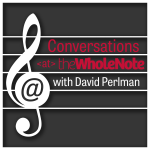 Welcome to the Conversations <at> The WholeNote podcast page. Below you will find our podcast episodes for your listening pleasure.
Welcome to the Conversations <at> The WholeNote podcast page. Below you will find our podcast episodes for your listening pleasure.
To listen, you have a few options:
If you are unable to find us on the podcast app that you use, please let us know and we'll do our best to try and make it available to you.
Scroll down to select individual episodes to enjoy.